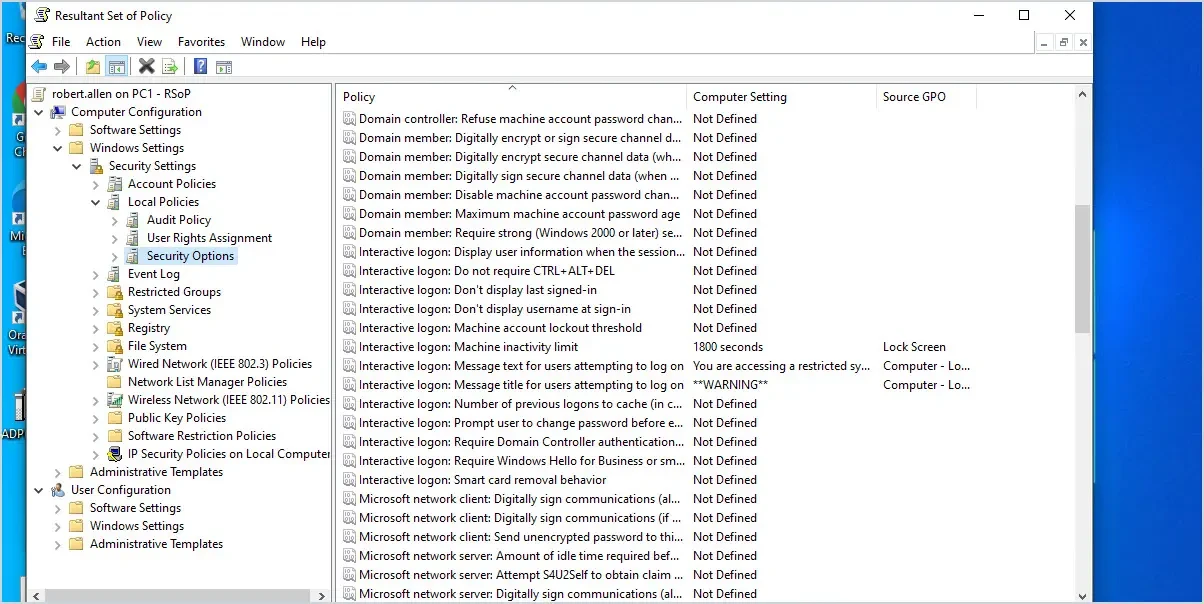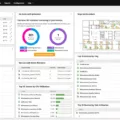Are you looking for a way to track and manage your Group Policy settings? Resultant Set of Policy (RSoP) can help! RSoP is a Windows tool that enables you to discover which policy settings have been applied to local and remote computers. It’s an invaluable tool for IT administrators and security professionals, as it helps them stay on top of their organization’s Group Policy settings.
RSoP works by collecting data from the computer’s registry as well as from Active Directory. It then creates a report detailing which policies are applied to the user or computer, including information about any security settings that may be in effect. This report can be used to troubleshoot issues, verify policy configurations, or identify potential security risks.
Using RSoP is easy – all you need to do is open up the command line and type ‘rsop.msc’. The tool will then generate a report for both the user and computer policies currently in effect. The report will include detailed information about each setting, including its source (whether it was applied through a domain-based policy or local policy), when it was last modified, and who made the change.
RSoP is an incredibly powerful tool that can save IT administrators hours of time when managing their organization’s Group Policy settings. It’s also an excellent resource for security professionals who are looking to ensure their organization’s data remains secure. So if you’re looking for a way to easily track and manage your Group Policies, give RSoP a try!

Differences Between Gpresult and RSoP
Gpresult and RSoP are both command-line tools used to display applied group policies. However, there is an important difference between the two tools. Gpresult is a more comprehensive tool that can show all the possible sets of applied policies to the user and computer, while RSoP will only display a limited set of group policies that were applied to the computer. Gpresult can also provide more detailed information about each policy, including its source, type, and any exceptions that have been applied. Therefore, if you need a full picture of the applied group policies on a system or user account, Gpresult is the better choice.
The Difference Between RSoP and GPedit
The main difference between Group Policy Resultant Set of Policy (RSoP) and GPEDIT.MSC is the scope of their functionality. RSoP provides a detailed report on the settings that have been applied to a user or computer based on all the Group Policy Objects (GPOs) from both local and domain sources, while GPEDIT.MSC is used to manage only the local Group Policy settings. RSoP can help you identify all the GPOs that are applied to a user or computer, whereas GPEDIT.MSC is useful for making changes to any of the local GPOs.
Can RSoP Be Run on a Remote Computer?
Yes, you can run the Resultant Set Of Policy (RSoP) tool on a remote computer. To do this, you must first install the Group Policy Management Console (GPMC) on a computer with administrative rights. Once the GPMC is installed, you can use it to connect remotely to the target computer and then run an RSoP query to view detailed information about what policy settings are applied. You can also use the GPMC to create and deploy policy changes to the remote computer as well.
Checking RSoP Results
In order to check your Resultant Set of Policy (RSoP) results, you’ll need to open the command line interface on your computer. Once the command line is open, type in rsop.msc and hit enter. After a moment, the RSoP report should appear on your screen. This report will contain information about the user and computer policy settings on your machine, as well as any changes that have been made in the past.
You can also use the RSoP to compare different user or computer policies for potential conflicts between them. In addition, it’s possible to view the effects of policy changes before they are applied by using the simulation option within RSoP.
Once you have finished checking your RSoP results, you can close the command line interface and continue working with whatever other tasks you may have.
Understanding the Resultant Set of Policy (RSoP)
A Resultant Set of Policies (RSoP) is a tool used to help administrators understand the effect of Group Policy settings in an Active Directory environment. It allows administrators to query existing and planned policies and then report the results of those queries. This helps administrators quickly identify the impact of Group Policy on user and computer accounts.
RSoP can be used to troubleshoot policy issues by providing a detailed report of all Group Policies that are being applied, including any conflicts between them. It also provides information about when a policy was applied and which client computer it was applied to. This can help identify potential problems with policies before they cause serious issues.
RSoP is especially useful for tracking down issues with users who may not be able to access resources or who have unexpected behavior because of conflicting or unapplied policies. By running an RSoP query, administrators can quickly determine what policies are causing the issue and adjust them accordingly.
Overall, RSoP is an invaluable tool for managing Group Policy in an Active Directory environment, as it provides quick visibility into how the policies are affecting users and computers.
The Impact of Group Policy on Resultant Outcomes
Resultant Set of Policy (RSoP) is a feature of Group Policy that provides an administrative tool for analyzing the impact of Group Policy settings on users and computers in Active Directory. RSoP allows administrators to view the effective settings from all GPOs that are applied to a user or computer, as well as any conflicts between the policies. This report can be used to troubleshoot issues related to Group Policy, verify if certain policies are being applied correctly, and detect any policy misconfigurations. RSoP also allows administrators to identify any potential security risks resulting from Group Policy settings, and make changes as necessary.
Tools for Performing RSoP Analysis
Group Policy Result (gpresult) is a command-line tool that allows you to quickly analyze the RSoP data on a computer. It can provide you with a detailed report of the settings applied to the current user and computer, as well as any policy settings that have been filtered out or not applied.
Group Policy Update (gpupdate) is another command-line tool that allows you to quickly refresh local policy settings on a computer. This can be useful if you need to update the RSoP data on a specific computer without having to wait for a scheduled synchronization.
Finally, the RSoP snap-in allows you to view and analyze all RSoP data for computers in an Active Directory domain. This snap-in provides an interactive graphical interface for exploring the data, allowing you to get an in-depth look at which policies are being applied and what their settings are.
Retrieving GPResult from a Remote Computer
To get GPResult from a remote computer, you can use the gpresult /s command followed by the name of the remote computer. This command will display the Group Policy information and settings on that remote computer or server. In order to make sure that your connection is secure, you should ensure that you are using a secure connection when running this command. Additionally, you should also have administrative privileges on the remote computer in order to make changes to its configuration.
Running a GPResult Report
To run a GPResult report, you must first open the command prompt. Once the prompt is open, type in ‘gpresult’ followed by any desired parameters. The parameters you can use are as follows:
/h – Generates an HTML report of policy settings.
/scope – Specifies the scope of the query (user or computer).
/r – Displays only RSoP information for the specified user and computer.
/v – Verbose mode, which displays all settings applied from all GPOs.
/z – Displays RSoP information in XML format.
/s – Specifies a remote computer to generate the report on.
/u [\] – User to generate RSoP information on the local computer.
For example, if you wanted to generate an HTML report of policy settings for a specific user and computer, you would type in ‘gpresult /h /r /u [domain]\[username]’ into the command prompt and hit enter to run it.
Does GPResult Show Computer Policies?
Yes, GPResult does show computer policies. The gpresult command is a helpful tool for displaying the resulting set of policy settings that were enforced on the computer for the specified user when they logged on. The /v and /z options provide a comprehensive report of the Group Policy settings that are applied to the specified user and computer, including any applicable computer policies. To get an even more detailed report, you can redirect the output to a text file by using the syntax “gpresult/z >policy”.
Does the Default Domain Policy Appear in GPResult?
Yes, the Default Domain Policy is one of the policies that will show in GPResult. GPResult displays a list of all Group Policy Objects (GPOs) that are applied to both the computer and the user, including the Default Domain Policy. This policy contains settings that apply to all users and computers in the domain, such as security settings and network access rules. When you run GPResult, it will also display information such as policy settings, GPO processing time, and any errors that occurred while processing the policies.
Conclusion
In conclusion, the Resultant Set of Policy (RSoP) is a powerful tool that provides valuable insight into the group policy settings applied to a user or computer. It is able to report on both local and domain-based policies and can help administrators identify any issues related to policy enforcement. The RSoP command can only display a limited set of group policies, but the GPRESULT command-line tool with various switches can display all possible sets of applied policies to users and computers. With its comprehensive reporting capabilities, RSoP is an invaluable asset for any organization looking to maintain secure and compliant policies across its network environment.








